key BMW M3 CONVERTIBLE 2001 E46 Owner's Manual
[x] Cancel search | Manufacturer: BMW, Model Year: 2001, Model line: M3 CONVERTIBLE, Model: BMW M3 CONVERTIBLE 2001 E46Pages: 195, PDF Size: 1.96 MB
Page 4 of 195
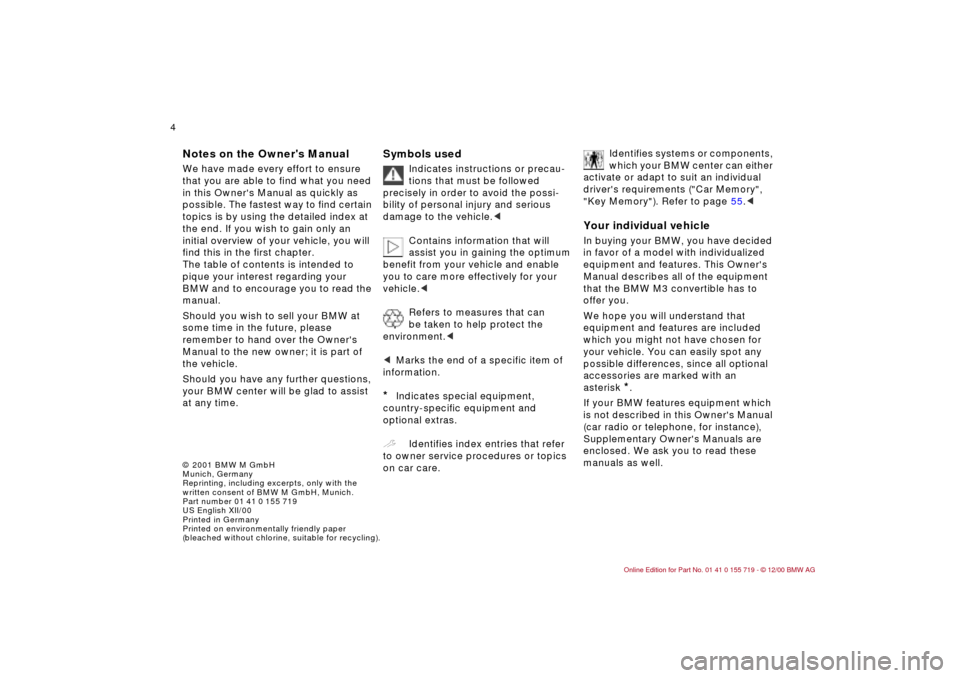
© 2001 BMW M GmbH
Munich, Germany
Reprinting, including excerpts, only with the
written consent of BMW M GmbH, Munich.
Part number 01 41 0 155 719
US English XII/00
Printed in Germany
Printed on environmentally friendly paper
(bleached without chlorine, suitable for recycling).
4n
Notes on the Owner's Manual
We have made every effort to ensure
that you are able to find what you need
in this Owner's Manual as quickly as
possible. The fastest way to find certain
topics is by using the detailed index at
the end. If you wish to gain only an
initial overview of your vehicle, you will
find this in the first chapter.
The table of contents is intended to
pique your interest regarding your
BMW and to encourage you to read the
manual.
Should you wish to sell your BMW at
some time in the future, please
remember to hand over the Owner's
Manual to the new owner; it is part of
the vehicle.
Should you have any further questions,
your BMW center will be glad to assist
at any time.
Symbols used
Indicates instructions or precau-
tions that must be followed
precisely in order to avoid the possi-
bility of personal injury and serious
damage to the vehicle.
<
Contains information that will
assist you in gaining the optimum
benefit from your vehicle and enable
you to care more effectively for your
vehicle.
<
Refers to measures that can
be taken to help protect the
environment.
<
<
Marks the end of a specific item of
information.
*
Indicates special equipment,
country-specific equipment and
optional extras.
t
Identifies index entries that refer
to owner service procedures or topics
on car care.
Identifies systems or components,
which your BMW center can either
activate or adapt to suit an individual
driver's requirements ("Car Memory",
"Key Memory"). Refer to page 55.
<
Your individual vehicle
In buying your BMW, you have decided
in favor of a model with individualized
equipment and features. This Owner's
Manual describes all of the equipment
that the BMW M3 convertible has to
offer you.
We hope you will understand that
equipment and features are included
which you might not have chosen for
your vehicle. You can easily spot any
possible differences, since all optional
accessories are marked with an
asterisk
*
.
If your BMW features equipment which
is not described in this Owner's Manual
(car radio or telephone, for instance),
Supplementary Owner's Manuals are
enclosed. We ask you to read these
manuals as well.
Notes
Symbols
The individual vehicle
Page 10 of 195

Contents
Overview
Controls and features
Cockpit16
Instrument cluster18
Indicator and warning lamps20
Multifunction steering wheel
(MFL)24
Hazard warning flashers25
Warning triangle25
Refueling26
Fuel specifications27
Tire inflation pressures27
Opening and closing:
Keys32
Electronic vehicle
immobilizer33
Central locking system33
Opening and closing – via the
door lock34
Opening and closing – via the
remote control35
Opening and closing – from
inside38
Luggage compartment lid39
Luggage compartment40
Alarm system42
Electric power windows44
Convertible top45
Adjustments:
Seats48
Mirrors52
Seat and mirror memory54
Steering wheel55
Car Memory, Key Memory55
Passenger safety systems:
Safety belts57
Transporting children safely58
Airbags61
Rollover protection system64
Driving:
Steering/Ignition lock66
Starting the engine66
Switching off the engine67
Parking brake67
Manual transmission68
Turn signal indicator/Headlamp
flasher69
Washer/Wiper system69
Rear window defroster71
Cruise control71
Everything under control:
Odometer73
Tachometer73
Engine oil temperature gauge73
Fuel gauge74
Coolant temperature gauge74
Service Interval Display75
Check Control76
Clock76
Computer77
Technology for safety and
convenience:
Park Distance Control (PDC)79
Dynamic Stability Control
(DSC)80
Tire Pressure Warning (RDW)81
M Engine dynamics control83
Contents
Page 20 of 195
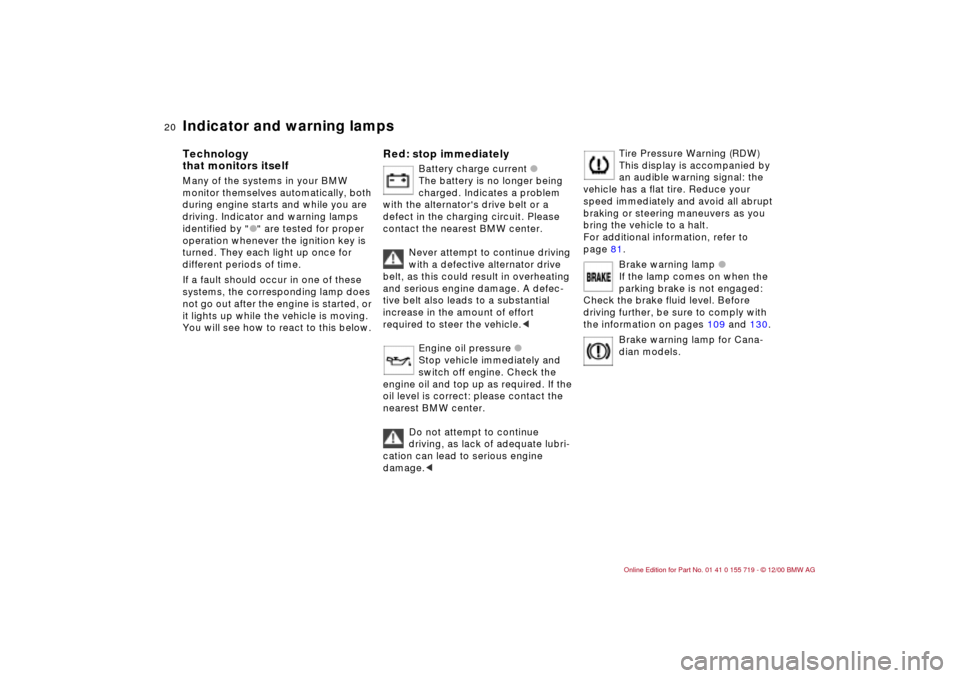
20n
Indicator and warning lamps
Technology
that monitors itself
Many of the systems in your BMW
monitor themselves automatically, both
during engine starts and while you are
driving. Indicator and warning lamps
identified by "
l
" are tested for proper
operation whenever the ignition key is
turned. They each light up once for
different periods of time.
If a fault should occur in one of these
systems, the corresponding lamp does
not go out after the engine is started, or
it lights up while the vehicle is moving.
You will see how to react to this below.
Red: stop immediately
Battery charge current
l
The battery is no longer being
charged. Indicates a problem
with the alternator's drive belt or a
defect in the charging circuit. Please
contact the nearest BMW center.
Never attempt to continue driving
with a defective alternator drive
belt, as this could result in overheating
and serious engine damage. A defec-
tive belt also leads to a substantial
increase in the amount of effort
required to steer the vehicle.
<
Engine oil pressure
l
Stop vehicle immediately and
switch off engine. Check the
engine oil and top up as required. If the
oil level is correct: please contact the
nearest BMW center.
Do not attempt to continue
driving, as lack of adequate lubri-
cation can lead to serious engine
damage.
<
Tire Pressure Warning (RDW)
This display is accompanied by
an audible warning signal: the
vehicle has a flat tire. Reduce your
speed immediately and avoid all abrupt
braking or steering maneuvers as you
bring the vehicle to a halt.
For additional information, refer to
page 81.
Brake warning lamp l
If the lamp comes on when the
parking brake is not engaged:
Check the brake fluid level. Before
driving further, be sure to comply with
the information on pages 109 and 130.
Brake warning lamp for Cana-
dian models.
Page 24 of 195

24n
Multifunction steering wheel (MFL)
The buttons integrated in the multi-
function steering wheel (MFL) are
provided so that you can operate a
number of accessories quickly and
without being distracted from traffic
conditions. You can operate:
>selected radio functions
>the cruise control
>selected cellular phone functions
*.
In order to operate a system via
the MFL, the corresponding
systems must be activated.<
1 Horn: the entire surface
2 Radio/Telephone: select
3 Cellular phone: receive a call, start
dialing, terminate a call
4 Radio/Telephone: volume
5 Radio/Telephone: scan backward or
scan station keys or scroll through
the phone listings
6 Radio/Telephone: scan forward or
scan station keys or scroll through
the phone listings
7 Cruise control: activate stored
setting (resume)
8 Cruise control: accelerate and
store (+) as well as decelerate and
store (–)
9 Cruise control: activate/interrupt/
deactivate
Page 25 of 195

25n
IndexDataTechnologyRepairsCar careControlsOverview
Hazard warning flashers Warning triangle
*
Activating and deactivating: press
button.
The button flashes rhythmically when
the hazard warning flashers are on.
To help you locate the button in an
emergency, the button is also illumi-
nated whenever the vehicle's lamps are
on.
The turn signal function takes
precedence over the hazard
warning flasher function. Starting from
ignition key position 1, you are there-
fore able to use the turn signal, even if
the hazard warning flashers have been
activated.<
The hazard warning triangle is readily
accessible. It is stored in the container
for the onboard tool kit mounted in the
luggage compartment lid.
To open the container, loosen the wing
nut.
Always observe all legal regula-
tions requiring a warning triangle
to be carried in the vehicle.<
Page 30 of 195
30n
Locks and security systems:
Keys32
Electronic vehicle
immobilizer33
Central locking system33
Opening and closing – via the
door lock34
Opening and closing – via the
remote control35
Opening and closing – from
inside38
Luggage compartment lid39
Luggage compartment40
Alarm system42
Electric power windows44
Convertible top45
Adjustments:
Seats48
Mirrors52
Seat and mirror memory54
Steering wheel55
Car Memory, Key Memory55
Passenger safety systems:
Safety belts57
Transporting children safely58
Airbags61
Rollover protection system64
Controls
Page 32 of 195
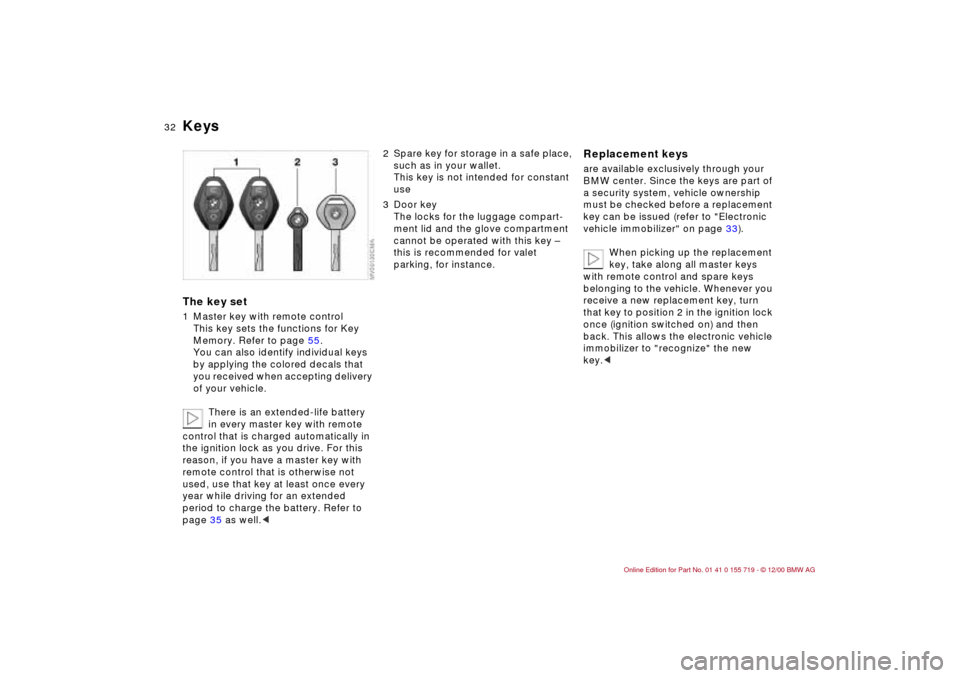
32n
KeysThe key set1 Master key with remote control
This key sets the functions for Key
Memory. Refer to page 55.
You can also identify individual keys
by applying the colored decals that
you received when accepting delivery
of your vehicle.
There is an extended-life battery
in every master key with remote
control that is charged automatically in
the ignition lock as you drive. For this
reason, if you have a master key with
remote control that is otherwise not
used, use that key at least once every
year while driving for an extended
period to charge the battery. Refer to
page 35 as well.<
2 Spare key for storage in a safe place,
such as in your wallet.
This key is not intended for constant
use
3 Door key
The locks for the luggage compart-
ment lid and the glove compartment
cannot be operated with this key –
this is recommended for valet
parking, for instance.
Replacement keysare available exclusively through your
BMW center. Since the keys are part of
a security system, vehicle ownership
must be checked before a replacement
key can be issued (refer to "Electronic
vehicle immobilizer" on page 33).
When picking up the replacement
key, take along all master keys
with remote control and spare keys
belonging to the vehicle. Whenever you
receive a new replacement key, turn
that key to position 2 in the ignition lock
once (ignition switched on) and then
back. This allows the electronic vehicle
immobilizer to "recognize" the new
key.<
Page 33 of 195
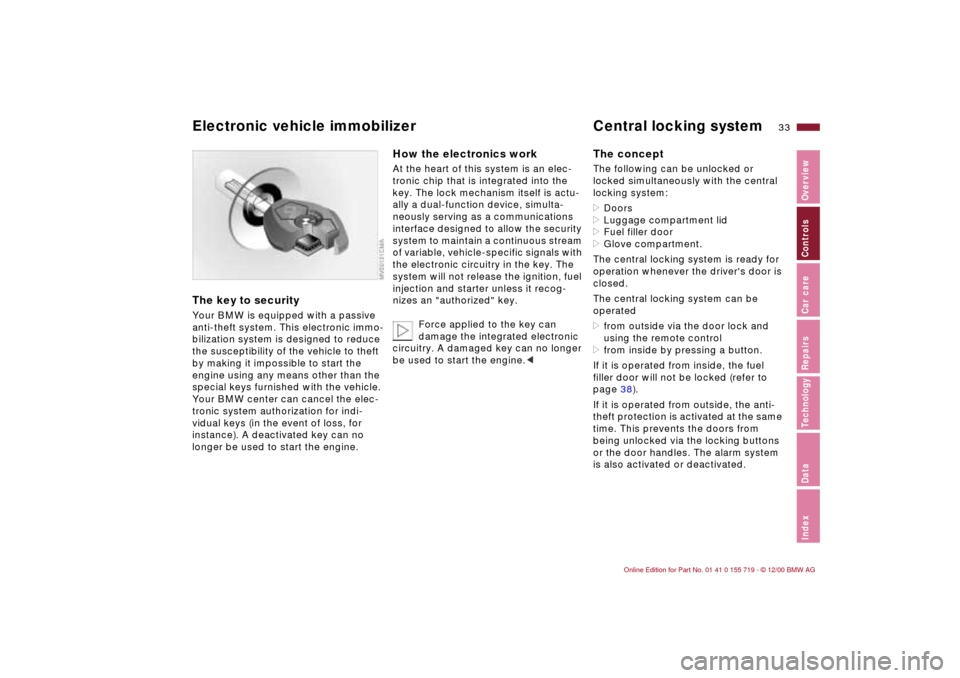
33n
IndexDataTechnologyRepairsCar careControlsOverview
Electronic vehicle immobilizer Central locking systemThe key to security Your BMW is equipped with a passive
anti-theft system. This electronic immo-
bilization system is designed to reduce
the susceptibility of the vehicle to theft
by making it impossible to start the
engine using any means other than the
special keys furnished with the vehicle.
Your BMW center can cancel the elec-
tronic system authorization for indi-
vidual keys (in the event of loss, for
instance). A deactivated key can no
longer be used to start the engine.
How the electronics work At the heart of this system is an elec-
tronic chip that is integrated into the
key. The lock mechanism itself is actu-
ally a dual-function device, simulta-
neously serving as a communications
interface designed to allow the security
system to maintain a continuous stream
of variable, vehicle-specific signals with
the electronic circuitry in the key. The
system will not release the ignition, fuel
injection and starter unless it recog-
nizes an "authorized" key.
Force applied to the key can
damage the integrated electronic
circuitry. A damaged key can no longer
be used to start the engine.<
The conceptThe following can be unlocked or
locked simultaneously with the central
locking system:
>Doors
>Luggage compartment lid
>Fuel filler door
>Glove compartment.
The central locking system is ready for
operation whenever the driver's door is
closed.
The central locking system can be
operated
>from outside via the door lock and
using the remote control
>from inside by pressing a button.
If it is operated from inside, the fuel
filler door will not be locked (refer to
page 38).
If it is operated from outside, the anti-
theft protection is activated at the same
time. This prevents the doors from
being unlocked via the locking buttons
or the door handles. The alarm system
is also activated or deactivated.
Page 34 of 195
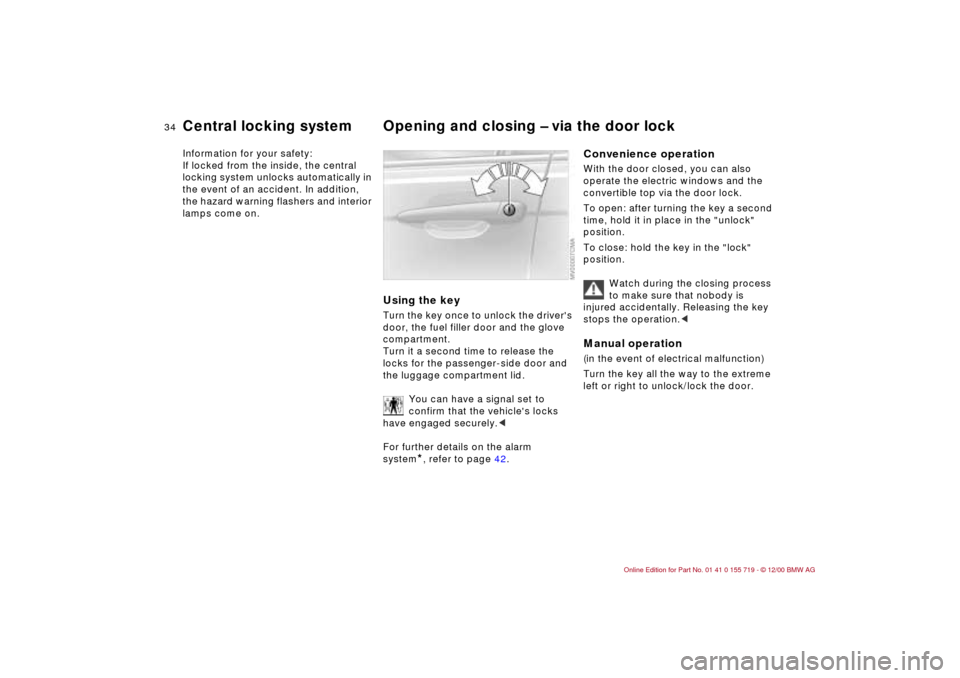
34n
Central locking system Opening and closing – via the door lockInformation for your safety:
If locked from the inside, the central
locking system unlocks automatically in
the event of an accident. In addition,
the hazard warning flashers and interior
lamps come on.
Using the keyTurn the key once to unlock the driver's
door, the fuel filler door and the glove
compartment.
Turn it a second time to release the
locks for the passenger-side door and
the luggage compartment lid.
You can have a signal set to
confirm that the vehicle's locks
have engaged securely.<
For further details on the alarm
system
*, refer to page 42.
Convenience operationWith the door closed, you can also
operate the electric windows and the
convertible top via the door lock.
To open: after turning the key a second
time, hold it in place in the "unlock"
position.
To close: hold the key in the "lock"
position.
Watch during the closing process
to make sure that nobody is
injured accidentally. Releasing the key
stops the operation.
left or right to unlock/lock the door.
Page 35 of 195

35n
IndexDataTechnologyRepairsCar careControlsOverview
Opening and closing – via the remote control The conceptThe remote control gives you an excep-
tionally convenient method for
unlocking and locking your vehicle.
Furthermore, it provides two additional
functions which you can only execute
via the remote control:
>Switch on the interior light. Refer to
page 36
With this function, you can also
"search for" your vehicle – when
parked in an underground garage, for
instance.
>Open the luggage compartment lid.
Refer to page 37
The luggage compartment lid will
open slightly, regardless of whether it
was locked or unlocked.
Whenever you unlock (lock) the vehicle,
you simultaneously deactivate (activate)
the anti-theft system, disarm (arm) the
alarm system
* and switch the interior
lamps on (off).
You can have a signal set to
confirm that the vehicle's locks
have engaged securely.<
To end the alarm: press button 1
(unlock, refer to page 36) or turn the
ignition key to position 1.
For further details on the alarm
system
*, refer to page 42.<
Master key with remote control
Children might be able to lock the
doors from the inside. For this
reason, always take the vehicle keys
with you so that the vehicle can be
opened again from the outside at any
time.<
Master keys with remote control
that are used repeatedly are
always ready for operation since the
battery in the key is charged automati-
cally in the ignition lock as you drive.
If it is no longer possible to unlock the
vehicle via the remote control, the
battery is discharged. Use this key to
drive for an extended period in order to
recharge the battery. Refer also to
page 32.
Guard the remote control against unau-
thorized use by only surrendering the
spare key or the door key (refer to
page 32), for valet parking, for instance.
In the event of a system malfunction,
please contact your BMW center. You
can also obtain replacement keys
there.<